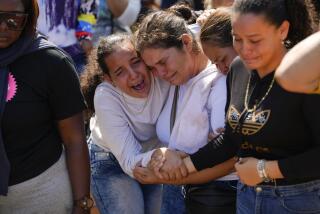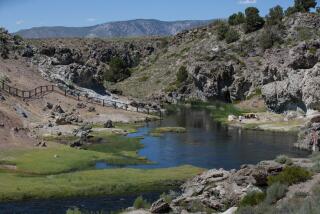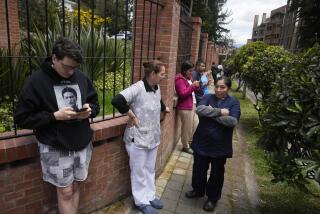False Alarm Spurs Fear of New Eruption
- Share via
ARMERO, Colombia — A false alarm from an official Saturday triggered fears that a new volcanic eruption was about to unleash huge torrents of mud like those that earlier smothered several towns and killed an estimated 22,000 residents of the Colombian Andes last week.
The mistaken report that the Nevado del Ruiz volcano had erupted again was issued Saturday afternoon on national radio and television by Noemi Sanin Posada, the Colombian minister of communications. An eruption of the same volcano late Wednesday night melted glacial ice on the peak and sent huge torrents of mud down steep canyons, burying the town of Armero and destroying parts of several villages.
Sanin Posada warned people living along rivers that descend from the volcano to evacuate their homes and move to higher ground. She said the evacuation should proceed “with the greatest tranquility and serenity, as is advisable in these cases, but rapidly, because we have to protect lives.”
Just hours later, however, Sanin Posada said in a second broadcast that “the state of alert continues but fortunately, everything indicates that this eruption will not have grave consequences as did the one three days ago.” She said there was no need to evacuate “for the moment.”
Dario Mosquera, a government geologist, declared Saturday night that there had been no new eruption, “but simply two explosions of small magnitude.” Scientific experts, including Darrell Herd of the U.S. Geological Survey, flew over the volcano to investigate and reported no signs of avalanches.
Mosquera said Saturday’s alarm was “a bit hasty” but he added, “It is much better to give hasty alarms than late ones.” If volcanic activity increases, he said, it could cause new melting of the snowcap and new avalanches.
“It all depends on the temperature,” he said. “If an explosion generates temperature, melting is produced.”
The government’s correction came too late for thousands of frightened Colombians who live in riverside towns and had already rushed from their homes to higher ground.
One radio report from Guayabal on Saturday night said about 1,500 residents had gathered on a hilltop but had begun returning to their homes after dark. Other broadcasts indicated that similar scenes were repeated in several other towns around the volcano.
The presidential palace issued a communique late Saturday declaring that “the zone presents no immediate danger.”
Meanwhile, efforts to save hundreds of people still trapped in Armero, the main disaster site, were stepped up, but Red Cross officials and physicians in the disaster area said those not lifted to safety by Saturday night stood little chance of survival.
Only two survivors were dug out of Armero’s rubble Saturday morning. Relief workers, who Friday had estimated that 1,000 to 2,000 people might still be alive in the submerged town, Saturday said they believe that 200 at most were still living.
In the town of Guayabal, a man stuck for three days in mud up to his waist snatched a knife from one of the rescuers trying to free him and committed suicide by stabbing himself five times in the stomach.
Elias Acosta, screaming in pain with both legs broken, stared wildly at the rescuers before grabbing the knife, student volunteer Jose Prospero told a local radio station.
Dr. Hector Orduz said Saturday that the thousands of unrecovered corpses in Armero had become a serious health hazard. Orduz, a national police physician in Guaybal, is in charge of caring for injured persons evacuated from Armero to Guayabal.
He said there should be no attempt to dig the bodies out of the mud, 30 feet deep in places.
“Let the government leave them buried there, let the government fumigate the place and declare it a holy ground,” Orduz said.
“It is already a holy ground (cemetery),” Health Minister Rafael de Zubiria said Saturday night in Bogota. “The number of Colombians who are definitively buried there is irrecuperable,” Zubiria said in a radio interview.
He said the exposed bodies in Armero would have to be incinerated quickly or buried in mass graves because of the danger of yellow fever and gastroenteritis. About 200 bodies from Armero have been buried in mass graves at Guayabal.
A Health Ministry bulletin Saturday said 20,354 persons apparently had died in Armero and nearby farms in the prime cotton-, coffee- and rice-growing area. It said 4,033 of the town’s 4,918 dwellings were destroyed.
A total of 22,341 persons were believed to have died in the disaster, and 4,529 were injured, the ministry said. The bulletin said deaths in Chinchina, on the west side of the volcano, were calculated at 1,817. More than 300 homes there were destroyed by mud that roared down the Chinchina River.
More to Read
Sign up for Essential California
The most important California stories and recommendations in your inbox every morning.
You may occasionally receive promotional content from the Los Angeles Times.










